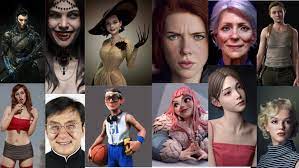For decades, games have unfolded on flat screens two-dimensional experiences constrained by pixels. While these games sparked creativity and shaped entire generations of players, the future is pushing beyond these boundaries. Today, advances in design, artistry, and technology are enabling developers to create worlds with depth, texture, and dimension that feel almost tangible.
One of the most exciting shifts lies in the rise of the 3D sculpture game, where digital artistry mirrors real-world sculpting techniques. By blending art and technology, developers are not only redefining visuals but also transforming how players interact with virtual environments. This revolution is not just aesthetic it is experiential, reshaping what immersion truly means.
The Rise of Dimensional Storytelling
Games have always been about storytelling, but traditional 2D formats limited the range of expression. With the adoption of 3D sculpting methods, narrative depth takes on new meaning. Characters feel alive, environments breathe, and objects carry weight that players can almost touch.
Dimensional storytelling allows developers to go beyond words and actions. A crumbling statue in a ruined city, carved in meticulous digital detail, can communicate centuries of history without dialogue. This is the artistry behind the 3D sculpture game, a genre where sculpted visuals enhance plotlines and make stories unforgettable.

Artistry Meets Technology: Sculpting the Future
At the heart of tangible game dimensions lies the fusion of artistry and technology. Game developers collaborate with digital sculptors to craft assets that mirror real-life sculptures, complete with textures, imperfections, and physical weight.
These assets are then integrated with engines capable of rendering high-resolution, interactive models. The result is a hybrid of art and code where chisels and clay are replaced by styluses and software. Through the 3D sculpture game, artistry becomes the foundation for technical innovation, enabling environments that feel both handcrafted and futuristic.
Why Tangibility Matters to Players
Tangibility goes beyond aesthetics; it directly influences how players connect with a game. When objects and environments appear physically real, players feel a stronger sense of presence. Picking up a weapon that looks sculpted from iron or walking through forests where every leaf feels textured enhances immersion dramatically.
This immersion impacts emotional engagement as well. Players care more about characters that look sculpted with care, or about environments that reflect natural decay and growth. The 3D sculpture game is not just about looking impressive, it's about creating emotional weight that draws players deeper into virtual worlds.
Redefining Immersion: The Multi-Sensory Shift
Flat screens provided only sight and sound, but dimensional games are unlocking multi-sensory immersion. While most players cannot physically touch objects, sculpted visuals create illusions of texture and depth that simulate tactile experiences. Pair this with haptic feedback and spatial audio, and the result is an environment that feels more real than ever before.
This multi-sensory shift also encourages longer engagement times. When environments feel alive, players want to explore them thoroughly. Developers using sculpted assets ensure that every interaction rewards curiosity, making the 3D sculpture game a genre where immersion is limitless.
The Role of Outsourcing in Sculpted Game Worlds
Creating sculpted 3D assets is resource-intensive. Studios often turn to specialized outsourcing teams who excel at digital sculpting, material design, and asset optimization. These partnerships allow developers to maintain artistic quality while meeting production timelines.
Outsourcing also expands creative diversity. Different teams bring unique styles and cultural influences, which enrich sculpted environments and characters. This global collaboration ensures that the 3D sculpture game reflects a variety of artistic traditions, appealing to wider audiences across the world.
Challenges in Building Tangible Dimensions
Despite its promise, building tangible game worlds comes with challenges. Rendering high-detail sculpted models demands powerful hardware and optimized workflows. Without proper management, games risk performance issues like lag or texture pop-ins.
Additionally, sculpted environments require balance between realism and playability. Too much detail can overwhelm players or distract from mechanics. Developers working on 3D sculpture game design must constantly refine this balance ensuring that games are both visually stunning and mechanically smooth.
Industry Examples: When Sculpting Transforms Play
Some of the industry’s most celebrated titles showcase the power of sculpted environments. Games like God of War and Elden Ring use sculpted characters and landscapes to convey mythology and emotion in ways flat art cannot. Each statue, cliffside, or relic feels part of a living history carved into the world.
Indie developers are also experimenting with sculpting techniques, using smaller-scale projects to push creative boundaries. These experiments highlight the versatility of the 3D sculpture game, proving that it is not just a AAA trend but a growing movement across the gaming spectrum.
The Future of Sculpted Dimensions in Gaming
Looking ahead, sculpted 3D assets will only become more integral to game design. As VR and AR technologies expand, tangible visuals will define how players interact with hybrid realities. Sculpting will no longer just shape static environments, it will craft interactive, dynamic worlds where every object can be touched, moved, or reshaped.
The 3D sculpture game of the future may even blur the line between player and creator. With accessible sculpting tools, players could become co-artists, leaving their mark on evolving worlds. This participatory model highlights the limitless potential of sculpted dimensions in redefining play.

Final Thoughts
The move beyond flat screens represents more than just a technical upgrade; it's a reimagining of how games connect with people. Sculpted dimensions deepen immersion, amplify storytelling, and create emotional resonance that flat visuals could never achieve.
As studios continue exploring this frontier, the 3D sculpture game will stand as a symbol of gaming’s evolution. Most importantly, its impact will resonate across all player types from competitive gamers seeking challenge to casual players chasing wonder. Sculpted dimensions ensure that every kind of player finds an experience that feels real, meaningful, and unforgettable.







